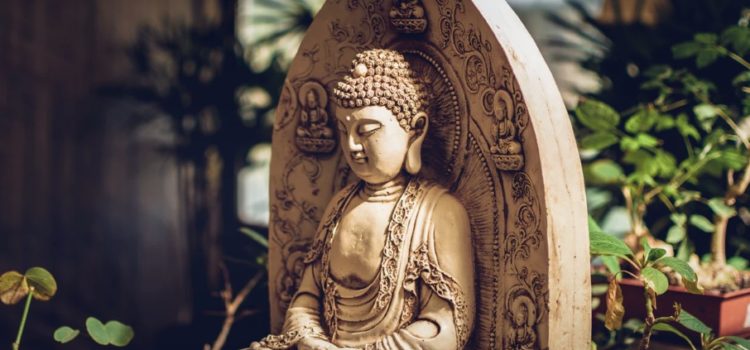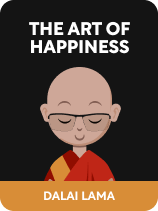

This article is an excerpt from the Shortform book guide to "The Art of Happiness" by Dalai Lama. Shortform has the world's best summaries and analyses of books you should be reading.
Like this article? Sign up for a free trial here .
What are the main teachings of the Dalai Lama? What advice does he profess?
In his book The Art of Happiness (co-authored with psychiatrist Howard C. Cutler), His Holiness the Dalai Lama walks you down the Buddhist path towards happiness. The Dalai Lama’s advice for achieving happiness is unique in its simplicity and flexibility: learn where your emotions come from and make the effort to change.
We’ll discuss several strategies to make that effort.
Strategy #1: Develop Your Self-Worth
According to the Dalai Lama, to actively cultivate your happiness mindset, develop your sense of self-worth, regardless of external circumstances. You don’t need possessions, beauty, or titles to validate you as a human. It’s important to not attach your self-worth to such things, he adds, as they can diminish over time, meaning your self-worth does the same.
(Shortform note: The Dalai Lama advises you to develop your self-worth to cultivate a happiness mindset. Doing this is important for practical reasons, too: When you lack self-worth, you might engage in destructive behaviors in your quest to “earn” your right to exist. In Dare to Lead, Brené Brown writes about employees who overwork themselves to prove their worth. This has negative consequences for the individual and the company.)
Strategy #2: Combat Negative Emotions With Positive Ones
When they arise, counter negative emotions with positive ones, says the Dalai Lama. For instance, when you find yourself consumed with self-reproach over a bad test grade, tell yourself that your worth isn’t dependent on grades and practice kindness toward yourself.
(Shortform note: For Brené Brown, self-compassion is a key tool for combating negative feelings, particularly harmful perfectionism. Brown breaks self-compassion into three parts: 1) Self-forgiveness, 2) self-awareness, and 3) recognition that you’re not the only person struggling with negative feelings.)
Cutler adds that Cognitive Behavioral Therapy, or CBT, is a close therapeutic equivalent to the Dalai Lama’s process of combating negative emotions with positive ones. In CBT, you counter distorted thoughts—like the belief that your work must be perfect—with rational ones—like the understanding that you’re human and can’t do everything perfectly.
(Shortform note: Cognitive Behavioral Therapy has a lot in common with this book’s approach to seeking happiness beyond this strategy of countering negative feelings with positive ones. In The Art of Happiness, you learn how to change your mind to be more conducive to happiness. In CBT, you similarly change or shift destructive thought patterns, like black-and-white thinking or catastrophizing. Both approaches aim to alter your mental framework.)
Strategy #3: Compare Yourself Favorably
Cutler chimes in to advise that you think about how much better off you are than others rather than about how much better off others are than you to change your mindset. Your happiness is largely dependent on how well you perceive yourself compared to others. You therefore can decide if you’ll be happy or disgruntled by comparing yourself to either those who are worse off or those who are better off.
(Shortform note: Cutler argues that happiness is relative and that you can make yourself happier by refraining from comparing yourself to those who are better off. But there’s also evidence that certain circumstances can unconditionally increase or decrease happiness. Living amidst war, poverty, or in isolation, for instance, can make you unhappy, no matter how much worse off someone else may be.)
Strategy #4: Appreciate What You Have
Change your mindset by being grateful for the things and qualities you do possess, rather than yearning for those you don’t, says the Dalai Lama. The reason for this is practical: If you try to constantly acquire better things, you’ll eventually run out of things to acquire. When that happens, you’ll become unhappy.
(Shortform note: The Dalai Lama brings up a practical reason to cultivate an appreciation for what you have. But in Buddhism, yearning or “craving,” as it’s commonly referred to, is the actual source of suffering, as described in the Second Noble Truth. This is because satisfying cravings creates only temporary pleasure—like eating sweets. Once that pleasure fades, you’re struck with a new craving and must satisfy that. This craving-and-satisfying keeps you locked in Samsara, the endless cycle of birth, suffering, and death.)
Strategy #5: Prioritize Happiness Over Pleasure
Learn the distinction between happiness and pleasure, and prioritize the pursuit of happiness to strengthen your happiness mindset, advises the Dalai Lama. Happiness is a lasting state of non-suffering while pleasure is ephemeral, contingent on factors outside of your control. A good meal is an example of pleasure: It eventually ends. Happiness, on the other hand, lets you be content even when the meal is over, or even if you don’t get to enjoy a meal. (Shortform note: The Dalai Lama recommends prioritizing happiness over pleasure, but you could argue that sometimes, it’s better to prioritize fleeting pleasures over long-term happiness. Research indicates that pursuing pleasure can lead to better emotional health while perpetually denying oneself pleasures—food, entertainment, sex, and so on—can lead to distress and anxiety. Perhaps the key is to carefully balance pleasure with happiness and ensure pleasures have a more lasting effect on your life by reflecting on or journaling about them.)

———End of Preview———
Like what you just read? Read the rest of the world's best book summary and analysis of Dalai Lama's "The Art of Happiness" at Shortform .
Here's what you'll find in our full The Art of Happiness summary :
- The Dalai Lama's Buddhist path toward happiness
- The use of scientific evidence to support the Dalai Lama's beliefs
- Concrete actions you can take to improve your outlook on life, relationships, and resilience






